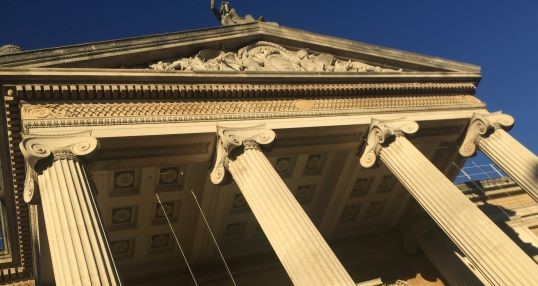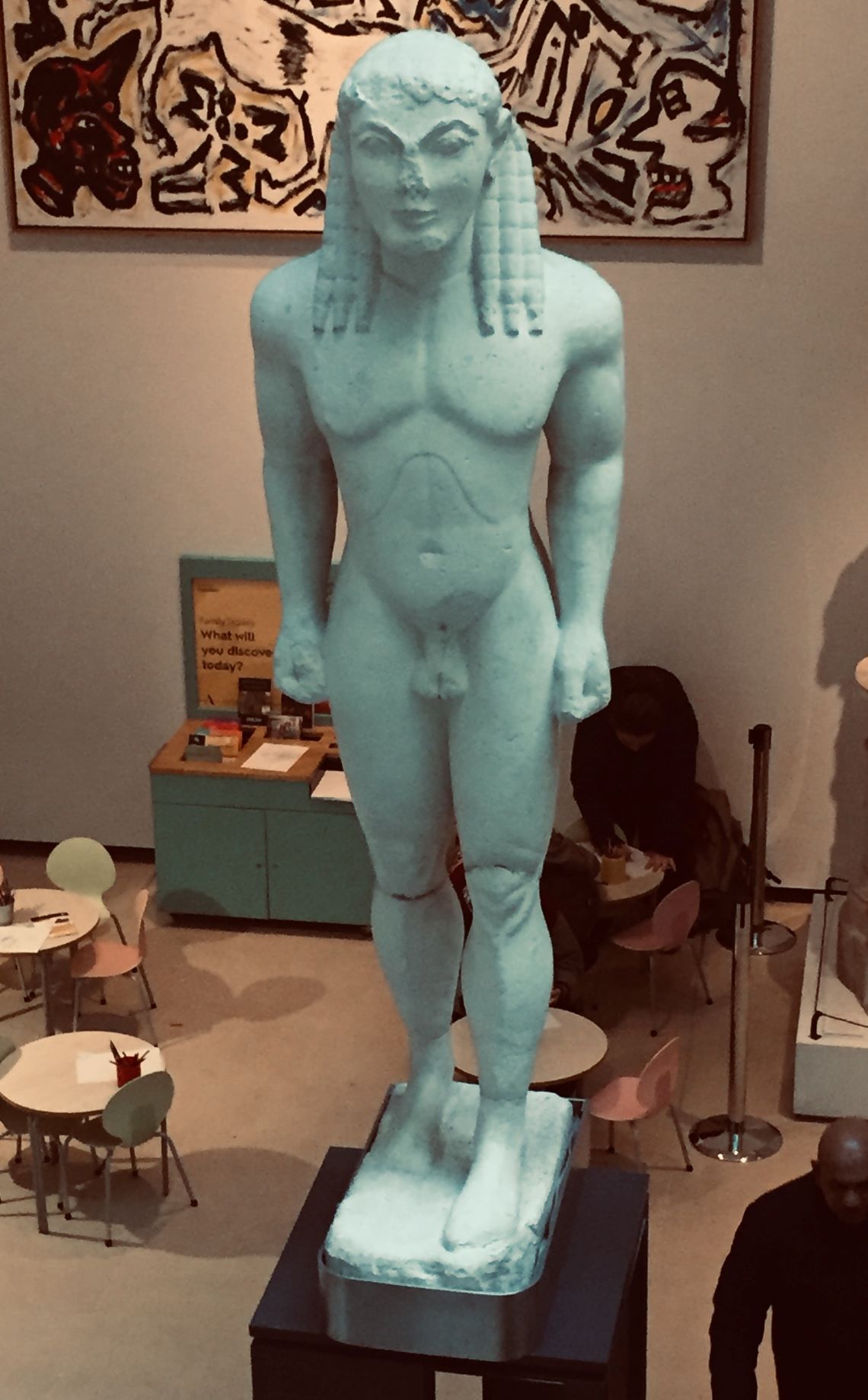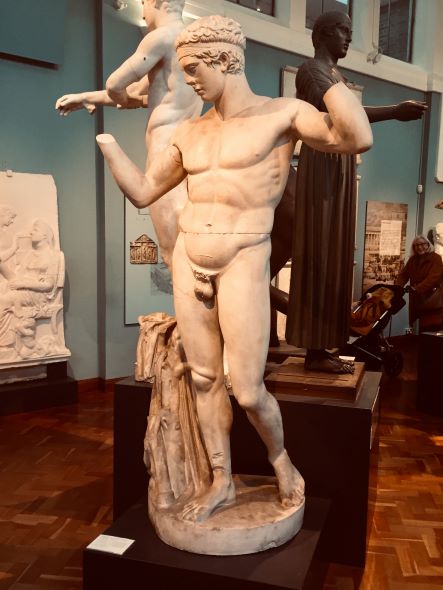A parental taxi-run to Oxford allowed for a hasty (15min) dash into the Ashmolean Museum and more specifically to the 'Cast Gallery' that began in 1884 as a resource for teaching classical archaeology. The following are a few 'snaps' I managed to take - along with a promise to come back and spend some quality time in the future! (spent almost more time in the loo than I did in the gallery 😆)

The text is taken either from the accompanying museum labels - or from the online catalogue.

Cast of early Greek kouros, Delphi, Greece,
c. 570 BCE
'The stocky, heavily muscled naked figure stands
in the schematic ‘walking’ pose copied from
Egypt by early Greek sculptors, signifying motion
and life. One of a pair excavated in the sanctuary
of Apollo at Delphi (now in Delphi Museum). The pair used to be identified as
Kleobis and Biton, after a story in Herodotus about two statues at Delphi, supposedly of these two boys from Argos, who pulled their mother, a priestess, in a cart to a festival she needed to get to. The subjects are however more likely to be heroes
or exemplary worshippers of Apollo, the god of the sanctuary. Such figures could carry a range of different meanings.
The engraved and simply modelled body surface, and the large eyes and flat-topped head are typical of the earliest large-scale Greek statues. The long hair is elaborately carved in thick, beaded locks, an archaic aristocratic fashion of the period. The subject is beardless, yet has strong muscle development, a full scrotum, and a trimmed mat of pubic hair - he stands on the threshold of manhood.'
[Note that the hair on this kouros is shown coming over the shoulders, more like a kore - presumably a 'local' (in either time or place) variant in style?]

Cast of ‘Peplos kore’, from Athenian Acropolis,
c. 530 BCE
'The young woman held an offering in her
outstretched left hand (missing) and wears an
unusual combination of clothes: a thin underdress visible at her feet, a thick belted dress or
skirt, and a short mantle. The outer clothing
would have been brightly patterned and
painted.'
--------------------------------------------------------------------
Athens, Acropolis Museum, inv. 679.
Found in three fragments in the 1880s, northwest of the Erechtheion on the Athenian Acropolis.
Small statue of kore type. She has long hair falling in symmetrical tresses on either side of the head and down the back, held by fillet, and crowned by stephane. She wears a chiton, a long garment held by a belt, a long jacket, and a short mantle. Studies of remaining pigment on the original marble surface have revealed complex painted decoration, with animal friezes on the long garment and lotus-palmette and running spirals on the jacket.
In: Frederiksen, Rune, and R.R.R. Smith, The Cast Gallery of the Ashmolean Museum: Catalogue of plaster casts of Greek and Roman sculpture (Oxford: Ashmolean Museum, 2011)

Cast of Diadoumenos (hair- binder) of
Polykleitos, from Delos, c. 100 BCE
'A young athelete ties a fillet around his head
after winning a contest. The marble statue is a
sensitive Hellenistic version of a bronze victor
statue by the famous fifth century sculptor
Polykleitos of Argos, made in c430BC. Over forty
later copies attest the impact of this statue.'
--------------------------------------------------------------------
Athens, National Museum, inv. 1826.Found in 1894 in the House of Diadoumenos on Delos, Greece.
Statue of naked athlete tying fillet in hair. A himation and quiver are draped over the supporting trunk to his right. Hellenistic, c. 100 BC copy of a statue of 440-420 BC by Polykleitos of Argos.
In: Frederiksen, Rune, and R.R.R. Smith, The Cast Gallery of the Ashmolean Museum: Catalogue of plaster casts of Greek and Roman sculpture (Oxford: Ashmolean Museum, 2011)

Cast of Diskobolos (discus-thrower) of Myron,
460-440BC
'An athelete is coiled up in a taut, momentary
pose, about to throw the discus- one of the
pentathelete’s five events. The cast combines
a headless statue from Hadrian’s Villa at Tivoli
and the head of a statue found in Rome. Copied
closely from a lost bronze victor statue by the
Athenian sculptor, Myron, active c460-440BC.'
--------------------------------------------------------------------
Statue: Vatican, Museo Pio Clementino, Sala della Biga, inv. 2346. Head (Lancelotti Head): Museo Nazionale Romano, inv. 126371.
Statue found in 1791 at Hadrian’s Villa at Tivoli, east of Rome. The head found (with its body) in 1781 in Villa Palombara on the Esquiline Hill in Rome.
Statue of naked, male athlete with short hair throwing the discus. The cast combines a statue in the Vatican with the head of a statue in the Museo Nazionale (ex. coll. Lancellotti). Roman, 2nd century AD, copying statue of c. 450 BC by Myron of Eleutherai.
Modern: lower left arm with hand, right lower leg with foot, fragments of body, right arm and diskos.
In: Frederiksen, Rune, and R.R.R. Smith, The Cast Gallery of the Ashmolean Museum: Catalogue of plaster casts of Greek and Roman sculpture (Oxford: Ashmolean Museum, 2011)

#
Emperor Augustus, from Villa of Livia at Prima Porta, near Rome c. 20 BCE'Augustus raises his right arm in the gesture of a general addressing his troops. The military commander's cloak and armour were the most distinctive of all Roman power costumes. The breastplate carries an elaborate allegory of the return of the standards lost to the Parthians in 19 BCE. The marble statue was once brightly painted'
'At the time of its discovery (1863), extensive remains of the statue's colouring were visible. In this reconstruction, the original pigments were recreated and their approximate shades were applied on the cloak, parts of the armour, the hair, the eyes, but not on the skin or on the ground of the armour, which were originally left uncoloured. The result shows some of the startling effect of polychromy applied to statues in antiquity.'
--------------------------------------------------------------------
Second, painted cast of the same original as B 161.
Cast acquired in 2009 from the Musei Vaticani. Reconstructed polychrome version produced under the scientific direction of P. Liverani.
In: Frederiksen, Rune, and R.R.R. Smith, The Cast Gallery of the Ashmolean Museum: Catalogue of plaster casts of Greek and Roman sculpture (Oxford: Ashmolean Museum, 2011)





 #
#